TRAIL HAPPENINGS June 2014
Retracing the Old Spanish Trail in Grand County
Adapted by Kathy Grossman
from trip reports and various sources
Forest Service archaeologist Bob Leonard called it, “the longest, crookedest, toughest pack trail in North America,” and last fall a group of American Conservation Experience (ACE) interns experienced nearly 400 miles of Utah’s Old Spanish National Historic Trail. They hiked, biked, drove, and rode horseback while meeting with historians, recreation planners, archaeologists, paleontologists, and local guides as they retraced the historic route. The goal was to expose the exciting opportunities along the Old Spanish Trail and encourage younger generations of public land users to explore Utah’s amazing landscape.
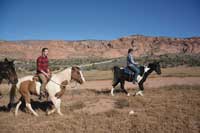 The Old Spanish Trail is a pageant of geologic time revealed in a 500-million year-old layer cake of cliffs, canyons, arches, and spectacular rock formations. Cryptobiotic crusts, ancient junipers, and desert cacti conceal a dense concentration of undisturbed archaeological sites. “You are looking at the highway of the 1800s,” said Old Spanish Trail Association Member Al Matheson. The Old Spanish Trail is a pageant of geologic time revealed in a 500-million year-old layer cake of cliffs, canyons, arches, and spectacular rock formations. Cryptobiotic crusts, ancient junipers, and desert cacti conceal a dense concentration of undisturbed archaeological sites. “You are looking at the highway of the 1800s,” said Old Spanish Trail Association Member Al Matheson.
Stretching 1,200 miles (1,900 kilometers), this “highway” was based on ancient Native American Indian trade routes and saw extensive use by Spanish pack trains from about 1830 until the mid-1850s, connecting northern New Mexico settlements around Santa Fe, New Mexico, with California’s Mission San Gabriel Arcangel and El Pueblo de la Reina de Los Angeles.
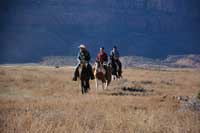 In autumn months, upper Rio Grande pack trains carried woolen textiles and raw wool. Woolen merchants then exchanged their goods (often serapes and blankets) for horses and mules, which were then driven back over the trail back to New Mexico. A trading party would usually leave Santa Fe in early November to take advantage of winter rains to cross the deserts, arriving in California in early February. The return party (with hundreds and sometimes thousands of horses and mules) would leave California for New Mexico in early April, before water holes dried up and melting snow raised the rivers too high. The trail was also used for illicit trade, such as horse raids and the human trafficking of Native American women and children. In autumn months, upper Rio Grande pack trains carried woolen textiles and raw wool. Woolen merchants then exchanged their goods (often serapes and blankets) for horses and mules, which were then driven back over the trail back to New Mexico. A trading party would usually leave Santa Fe in early November to take advantage of winter rains to cross the deserts, arriving in California in early February. The return party (with hundreds and sometimes thousands of horses and mules) would leave California for New Mexico in early April, before water holes dried up and melting snow raised the rivers too high. The trail was also used for illicit trade, such as horse raids and the human trafficking of Native American women and children.
Mimicking a return trail journey, the group left Green River and headed southeast to Moab, gazing over rolling, shrubby vistas that disappeared into shadowy hints of distant canyons. The La Sals’ fabled peaks rode the southeastern horizon as the final reds, oranges, and purples of the desert sun set to the west. Expansiveness and solitude have a way of bringing stories embedded in the land back to life, and it felt so right to be riding the trail as it was meant to be traveled, on horseback.
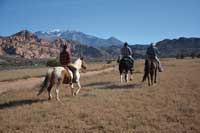 The Moab section of the Old Spanish Trail is well known for its riding opportunities, and the Canyonlands Backcountry Horsemen generously provided horses for the interns. A section of the trail in Arches National Park was even placed on the National Register of Historic Places in 1988. With the majestic La Sal Mountains ahead, the swaying saddles beneath them, and the rhythmic beat of the horses’ hooves, ACE interns became cowboys and cowgirls in the harsh yet beautiful landscape. The Moab section of the Old Spanish Trail is well known for its riding opportunities, and the Canyonlands Backcountry Horsemen generously provided horses for the interns. A section of the trail in Arches National Park was even placed on the National Register of Historic Places in 1988. With the majestic La Sal Mountains ahead, the swaying saddles beneath them, and the rhythmic beat of the horses’ hooves, ACE interns became cowboys and cowgirls in the harsh yet beautiful landscape.
Crossing the Colorado in Moab, 19th century trail riders would have gone south through Monticello and then entered Colorado via Dove Creek and Mancos, then traveled east along southeastern Colorado past the San Juan Mountains, avoiding the Colorado River’s Grand and Glen Canyons, and continuing south to Santa Fe.
Whether you ride north or south along this ancient trade corridor, the Old Spanish Trail provides a taste of timeless non-motorized travel for the equestrian adventurer.
Kathy Grossman, Trail Mix Editor, adapted material from American Conservation Experience (ACE) Paleontology Permitting Intern, Hannah Cowan, the BLM-Utah Public Affairs Staff, and Dick Walter, a member of Backcountry Horsemen and the equestrian representative for Trail Mix. For more information and maps of the Old Spanish Trail, go to www.oldspanishtrail.org including a video of the ACE trip, “Old Spanish Trail Adventure.”
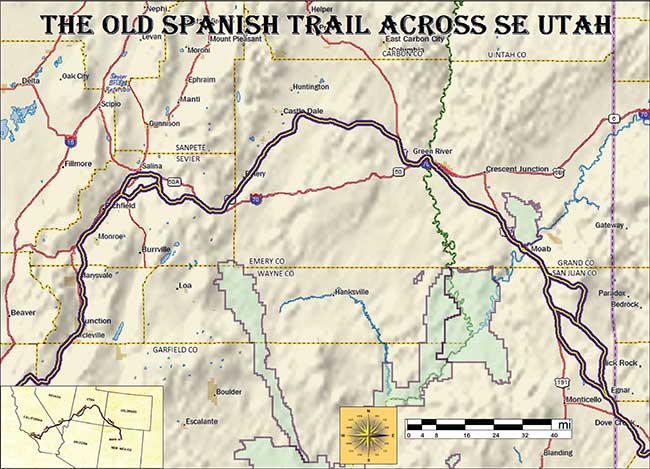
|
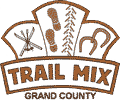 Trail Mix This committee represents non motorized trail users including: bikers, hikers, equestrians, and skiers. Many government agencies and private citizens comprise the “mix” that makes this group work so well. We meet the 2nd Tues. of each month from 12-2 at the Grand Center (500W. 182 N.). Everyone is welcome. Trail Mix This committee represents non motorized trail users including: bikers, hikers, equestrians, and skiers. Many government agencies and private citizens comprise the “mix” that makes this group work so well. We meet the 2nd Tues. of each month from 12-2 at the Grand Center (500W. 182 N.). Everyone is welcome.
Contact Sandy Freethey 259-0253 or find us online: wwwgrandcountyutah.net/trailmix/ or at moabtrailmixinfo@gmail.com.
|
|